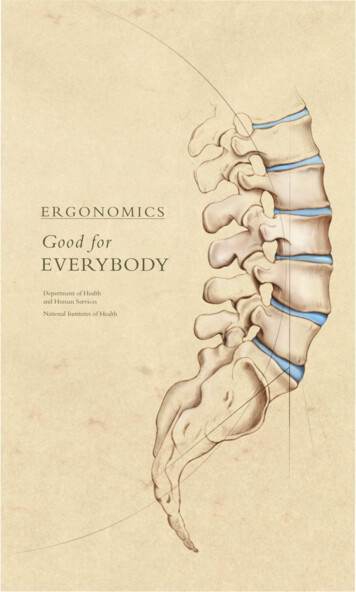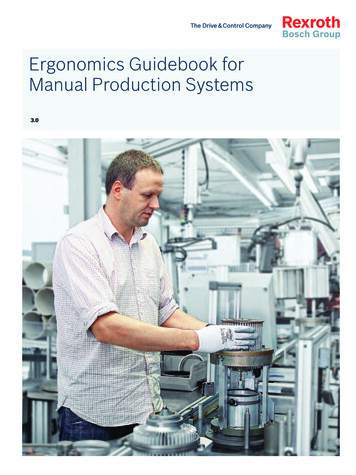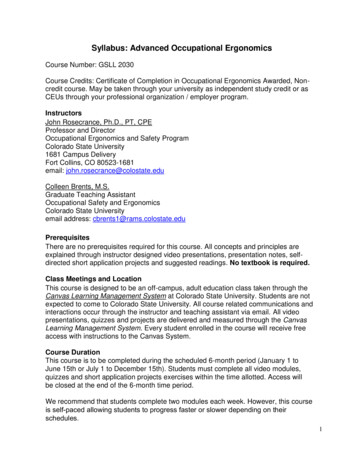
Transcription
ERGONOMICSGood forEVERYBODYDepartment of Healthand Human ServicesNational Institutes of Health
Divisionef Occupational Health and Safety, ORSBuilding 13, Room 3K0413 South Drive, MSC 5760Bethesda, MD 20892301.496.3457301.496.3353http://go.usa.gov/3 BwmA
ERGONOMICSGood forEVERYBODYPreventing Ergonomic Risk Factorsin Office, Laboratory, Industrial andHealthcare Settings.Tips For Correcting Common Laboratory Computer Workstation Lifting IssuesMay 2015
ERGONOMICS:LaboratoryWorkstationGood for EVERYBODYUsing a Microscope Use a non-porous, easy to clean chairthat provides good back support. Sit close to your work surface. Remove false fronts and suppliesfrom under the bench work area. Avoid leaning on hard edges. Pad forearms and edges of tables and workstations.Laboratory researchersare at risk for repetitivestress injuries duringroutine laboratoryprocedures such as Keep elbows close by the side of your body. Work with wrists in straight, neutral positions. Adjust your chair, workbench, or microscopeas needed to maintain an upright head position.pipetting or workingat microscopes. Elevate, tilt or move the microscope close to theedge of the counter to avoid bending your neck.Research has shownthat appropriateposture at yourworkstation can helpprevent a variety ofergonomic type Use adjustable eye-pieces or mount your microscopeon a 30 degree angle stand for easier viewing. Keep microscopes repaired and clean. Spread microscope work throughout the dayand between several people, if possible.conditions such astendonitis and carpaltunnel syndrome. Take breaks. Every 30 minutes, close your eyesor focus on something in the distance.Biological Safety Cabinets,Chemical Fume Hoods and Workbenches Remove drawers and supplies from under the work area. Use anti-fatigue floor mats if standing for long periods. Use a chair that provides adequate back support, adjustableseat angle, and height adjustability between 28 inches to 33inches. Use footrests and foot rings for leg support. Avoid resting your forearms on hard edges. Pad forearms, elbows or hard edges of the work benchesand cabinets. (Avoid interference with air flow.) Position work supplies as close to you as possible. Place equipment on approved turntables designedfor laboratory use, for easy retrieval. Take short breaks to stretch musclesand relieve forearm and wrist pressure.
Pipetting Use anti- fatigue floor mats or shoe insolesif standing for long periods. Sit supported against the backrest of your chair. Sit or stand close to your work at bench cut outs. Adjust your chair to proper work height rather than jutting outyour chin or bending your neck down when working. Elevate your chair rather than reaching up to pipette. Do not twist or rotate your wrist while pipetting. Alternate or use both hands to pipette. Keep arms close to the body while pipetting. Hold the pipettor with a rel:L'l:ed grip. Use minimal pressure while pipetting. Use light force or two hands to change tips Use low profile tubes , solution containersand waste receptacles. Use thin-wall pipette tips that fit correctly and are easy to eject. Select a light- weight pipettor correctly sized for your hand. Use pipettors with finger aspirators and thumbdispensers to reduce thumb strain. Use latch-mode or electronic pipettorsfor repetitive pipetting. Take a 1 to 2 minute break after every20 minutes of pipetting.
ERGONOMICS:ComputerWorkstationGood for EVERYBODYSeatingAdjust the Chair HeightStart with your seat at the highest setting and then adjustdownward until your legs and feet feel comfortable.Sit Back in the ChairUse as much of the chair back as possible for support. Adjustlumbar support to provide comfortable lower back support.Ergonomic injuries arerapidly increasing aspeople spend moretime at the computer.Research has shownthat appropriate postureat your workstation canAdjust the Seat PanAdjust the seat pan to reach a comfortable position.The seat pan should extend about an inch on bothsides of your legs , and should not apply pressureto the back of your knees.Adjust the ArmrestsAdjust the height, width, and position of your armreststo one most comfortable for how you work. Considerlowering or swinging the armrests out of the way whennot in use so as to not inhibit your movement.help prevent a varietyof conditions such asback pain and carpaltunnel syndromeClear ObstaclesMake sure that the chair's casters (wheels) move smoothly,and that nothing obstructs your ability to position the chairin front of your desk and computer.* If you are purchasing a new office chair, consider onlythose with full adjustability. Refer to the ErgonomicEquipment list on the DOHS websitehttp://go.usa.gov/3BwmAKeyboard and MouseThe following adjustments should be made to yourworkstation to help prevent the development of anergonomic problem in the upper extremities: Adjust keyboard height so shoulders can relax andarms are allowed to rest at sides (an adjustablekeyboard tray is often necessary to accommodateproper height and distance). Keyboard should be close to the userto avoid excessive extended reaching. Forearms should be parallel to the floor(approximately 90 degree angle at elbow). The mouse should be placed adjacent to keyboardand at the same height as the keyboard(use articulating keyboard tray if necessary).
Monitor I Document Holder!TelephoneCenter the MonitorThe monitor should be placed directly in front of you toeliminate twisting your neck.Position the Monitor at Eye HeightPosition the top of the monitor approximatelyat seated eye level. (If you wear bifocals, lowerthe monitor to a comfortable reading level.)Sit at a Proper DistancePosition the monitor so that it is at an arm'slength away from the body.Reduce Glare by Careful Positioningof the Computer ScreenPlace screen at right angles to windowsand adjust curtains or blinds as neededUse a glare screen when necessary.Position reading documents directly in front of youDocuments should be placed between the monitorand the keyboard , using an in-line copy stand.Place your telephone within easy reachTelephone stands can help reduce the need to reach. I:I. :'I'Use a hands-free headset and/or speaker phoneThis helps to eliminate cradling the telephonehandset betw\ en tl e nt; ck and the shoulders.·.
ERGONOMICS:ErgonomicLiftingGood for EVERYBODYKnow How to Protect Your Back When Lifting AnythingMaintain the Natural Curves in Your Back.These curves provide strength and support for yourback. This is especially important when lifting or whensitting for long periods.Tighten Your Stomach Muscles Before You Lift.They help support and stabilize your back when you lift.Back pain, such asfrom heavy lifting, isone of the mostcommon work-relatedPlan Ahead Before Lifting.Test the weight first. Many injuries result frompoor planning and overexertion.Keep Objects Close.A 10 pound bag of groceries can put 100 pounds ofpressure on your lower back. Holding things away fromyour body greatly increases this pressure.injuries. Applyingergonomic principals the study of theworkplace as it relatesPivot with Your Feet When Lifting and Moving Objects.Turn your whole body instead of twisting your back - especiallyif you are holding something heavy. Your nose should alwaysbe in-line with your toes.to the worker - canhelp prevent work-re lated back pain andback injury and help toStay in Good Shape.Exercise. Do daily stretches and watch your weight. Extra weight,muscle weakness, or muscle imbalances due to tightness, can affectyour posture and result in back discomfort or pain.maintain a healthy backPatient Care ErgonomicsAssisting another individual in a change of position requiresproper body mechanics on your part. Proper body mechanics(positioning) will make your job easier to perform and reducethe risk of injury. Proper body mechanics requires that thenatural curves of the spine are maintained in proper alignment.To do this successfully. Bend your knees to get up and down. Keep the object close to the body in order tominimize forces on your body. Pivot don't twist. Don't try to do more than you can handle. Respect your limits. Use patient lifting equipment as much as possible. Use the buddy system when lifting
Industrial and Shop ErgonomicsLifting is strenuous - it requires proper training and technique.By lifting with your large, strong leg muscles instead of thesmall muscles of the back, you can prevent back injuriesand reduce low back pain. There are five steps to followwhen lifting an object: Get Close To The LoadGet as close to the load as possible - as if you're huggingthe object. Having the object close to your body put lessstress on your low back. Maintain the Curves in Your Back.Keep yourself in an upright position while squatting to pick up Tighten Your Stomach MusclesTightening the stomach helps support the spine.Don't hold your breath while tightening the muscles. Lift With Your LegsYour legs are the strongest muscles in your body - so use them. Pivot Don't TwistTurn with your feet, not your back. It isn't builtfor twisting from side to side.1--i-ILarge or Heavy Loads.If a load is too heavy to lift alone, ask for help. Pick one personto coach the lift - this way you lift and lower at the same time.)IOverhead Loads.If a load is above your shoulders, use a step stool toelevate yourself until the load is at least chest level - preferablywaist height. Pull the object close to your body and then lift.Reme1nber to maintain your curves - use your arms andlegs to do the work.
ERGONOMICS:Rest Breaks/Exercise TipsGood forEVERYBODYTake short 1-2 minute stretch breaks every20-30 minutes. Use these rest breaks to performa few office exercises.Eye Exercises Blinking (produces tears to helpmoisten and lubricate the eyes) Expose eyes to natural light Follow the 20-20-20 Rule. Refocus eyeson an object that is 20 feet away, for20 seconds , every 20 minutes.Division of OccupationalHealth and SafetyBuilding 13, Room 3K04N eek ExercisesTilt head to one side (ear towards shoulder) holdfor 15 seconds, and repeat 3 times on each side.13 South Drive, MSC 5760Bethesda, MD mAShoulder ExercisesSlowly bring shoulders up to the ears andhold for approximately 3 seconds, rotateshoulders back and down repeat 10 timesHand/Forearm ExercisesMassage the inside and outside of the handusing the thumb and fingers; repeat frequently(including before beginning work). Hold armstraight out in front ofyou,pull the handbackwards with the other hand, then pulldownward, hold for 20 seconds , 3 times each.Back ExerciseSit in a chair. Reachacross body and grabthe back of the chair.Pull gently to increasethe stretch in themiddle of your back.Hold 5-10 seconds.Repeat reachingto opposite side./
To Learn MoreTo learn more about the NIH ErgonomicsProgra1n, visit the website at:http://go.usa.gov/3BwmAReporting Ergonomic InjuriesAs with any injury, it is important that you reportyour symptoms at the first sign of discomfort to yoursupervisor and Occupational Medical Service. Failureto get medical assistance can lead to even further discomfort,lost work days, or even pennanent disability. ContactOccupational Medical Service at Building 10,Roo1n 6C306 at 301 496-4411DOHS Provides at No Cost the Following Services: An ergonomic evaluation of the employee'sworkstation or work area On-site Ergonomic Training ClassesTo schedule an ergonomic evaluationor presentation, call 301 496-3353or 301.496.3457.
National Institutes of Healtho;,;,;oo of o''"''''"'' """" '"' "''"" .
Ifa load is too heavy to lift alone, ask for help. Pick one person to coach the lift - this way you lift and lower at the same time. ) Overhead Loads. Ifa load is above your shoulders, use a step stool to elevate yourself until the load is at least chest level - preferably waist height. Pull the










